
* The F-117 finally went into combat in 1989 during the American invasion of Panama, and served prominently in the Gulf War two years later. It remained a prominent and highly effective weapon in the US military arsenal until its retirement in 2008.
* The F-117 saw its first combat in December 1989, in Operation JUST CAUSE, the American invasion of Panama. Antagonism between the Americans and Panamanian dictator Manuel Noriega had led US President George Bush to order that Noriega be removed from power by force. F-117s were assigned to perform pinpoint bombing strikes as diversions to ground operations. Since the Panamanians had no real air defenses, the selection of the F-117 for the mission was based on its precision bombing capability, not stealth. The primary mission was for two F-117s to drop laser-guided bombs near Panamanian Defense Forces barracks in order to stun and confuse the defenders. Two others were to be on hand to back up an attempt to capture General Noriega, and two more came along as spares.
The six aircraft left Tonopah on the evening of 19 December and flew to Panama with the help of mid-air refueling. The attempt to capture Noriega didn't come off, and in the end only the two F-117s assigned to the primary target actually performed strikes. There was some confusion at the last moment and the aircraft missed their aim points, though the results were as desired. In any case, US military forces proved well-organized and efficient, and by the next day Panama was in American hands.
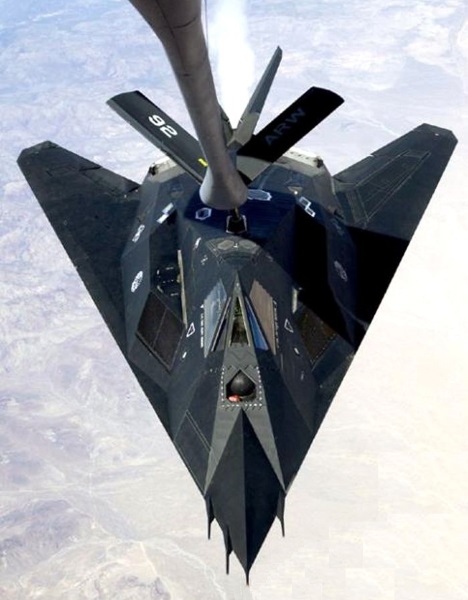
The use of the F-117 in the operation seemed to many as overkill, and public criticism of what appeared to be a Pentagon publicity stunt was loud and strident; it was not a very impressive combat introduction. Something more challenging was needed.
* In the early morning hours of 2 August 1990, three Iraqi armored divisions invaded the neighboring country of Kuwait. Kuwait fell quickly, and Iraqi dictator Saddam Hussein was then in a position to move into Saudi Arabia and assert control over the world's oil supplies. He stayed where he was, however, and within days American forces began to flow into Saudi Arabia.
On 20 August, F-117s left Tonopah to fly across the Atlantic to King Khalid Air Base in Saudi Arabia, arriving the next day. Their new home was at the southern tip of Saudi Arabia, well out of range of Iraqi Scud missiles, and was well-equipped with hardened shelters. It became known as "Tonopah East". The F-117 pilots soon began an intensive training program, since few of the pilots had combat experience in any sort of aircraft.
In the meantime, the confrontation with the Iraqis settled into a sitting war, with both sides trading propaganda and jockeying for political position. On 12 January 1991, the US Congress voted to allow the use of force to evict the Iraqis from Kuwait, in support of a UN resolution demanding that Saddam pull out of the country. On 15 January, the deadline specified by the UN resolution expired.
The next day, the F-117 pilots were briefed for their strikes. They would be among the leading elements in the air war, knocking out air-defense centers and other vital elements in the Iraqi war machine to allow conventional strike aircraft to make further raids unharmed. Baghdad, the capital of Iraq, was a prime target, and was defended by about 4,000 anti-aircraft guns and SAM launchers. The targets were at long range for the F-117, and the pilots would have to perform several inflight refuelings for each mission.
At 2:35 AM that following morning, Iraqi flak guns began firing into the skies over Baghdad, despite the fact that the air attacks hadn't begun yet. At 2:39 AM, US Army Apache helicopter gunships fired the first shots in the air war by knocking out early warning radars near the Iraqi border. By this time, eight F-117s were moving into Iraqi airspace, along with F-15E Strike Eagles that were assigned to destroy Scud missile launch sites in Iraq. At 2:51 AM, one of the F-117s dropped a laser-guided bomb on a bunker that contained an air-defense control center. The hardened bomb blew off the bunker's doors.
At 2:56 AM, the aimless firing from Baghdad went silent. There had been nothing to shoot at, though ironically the stealth fighters were just approaching the city, completely undetected. Moments later they hit communications centers; Iraqi Air Force Headquarters; an air-defense center; and one of Saddam Hussein's palaces. The Baghdad air defenses opened up again, while F-117s that still had bombs went on to hit secondary objectives. Minutes later, starting at 3:06 AM, a wave of Tomahawk cruise missiles began to hit leadership targets, such as the Iraqi Baa'th Party headquarters. Tomahawks armed with warheads that spewed out spools of conductive fibers shorted out power stations, knocking out the power grid.
At 3:30 AM, Iraqi air defenses picked up a huge attack force heading toward Baghdad. In reality, it was a fleet of decoy drones, backed up by conventional strike aircraft carrying AGM-88 high-speed antiradiation missiles (HARMs). As the air-defense radars locked onto the drones, the HARMs knocked out the radars.
At 4:00 AM, the second wave of F-117s hit Baghdad. Approach to the city was a fearsome experience. From 150 kilometers away, one pilot described it as looking like "a charcoal grill on the fourth of July", glowing with the fire of massed anti-aircraft guns. The Nighthawks hit some of the same targets bombed in the first wave, as well as air bases and command-and-control sites all over Iraq. The first two waves dropped 33 LGBs and scored 23 hits.
A third and final wave came in just before dawn to hit chemical and biological weapons bunkers. It was felt that sunlight would help kill anthrax spores scattered from the bioweapons sites. Unfortunately, cloudy weather made targeting difficult, and of 16 LGBs dropped, only five scored hits.
The F-117s returned to their Saudi Arabian base, their pilots feeling washed out and exhausted, glad to be alive. Much to their surprise, all of them came back. Despite worries, stealth worked. The F-117s had attacked one of the most heavily defended target areas on the planet with complete impunity.
* Over the next few days the F-117s returned to Iraq with confident pilots. The Iraqis poured anti-aircraft fire into the night sky over Baghdad, almost at random and without effect. One pilot simply lowered his seat so he couldn't be distracted by the fireworks, allowing him to concentrate on his target run.
A daylight attempt to attack Baghdad with conventional strike aircraft on 19 January failed, causing little damage to the target and the loss of two F-16s. From that point on, only F-117s or Tomahawks were used to attack the city. The F-117s continued the assaults on command-and-control centers, chemical-biological weapons dumps, and other targets. On 21 January, the Nighthawks hit and crippled a nuclear research facility in Baghdad, putting it out of operation. The Iraqis didn't know an attack was in progress until the bombs went off.
The next night, F-117s followed up daylight raids by F-111 strike aircraft to hit Iraqi Air Force hardened aircraft shelters. The strikes were made with conventional LGBs, however, and failed to dent the shelters. The Iraqis began to hide more of their aircraft away in the shelters. The night after that, the F-117s destroyed a set of Iraqi bombers that intelligence indicated were being loaded for a chemical attack, but the aircraft in the shelters remained safe for the moment.
The USAF realized the error, and re-armed the F-117s with hardened penetrator bombs. On the night of 24 January, they struck the shelters again, scoring 20 hits that punched into the shelters and blasted them out. Two days later, the Iraqi Air Force began to flee to Iran, where the aircraft were interned and repainted with Iranian markings. F-117 strikes on the shelters were stepped up to destroy as many Iraqi aircraft as possible before they could fly out of reach.
On 27 January, General Norman Schwarzkopf, head of Coalition forces, shifted most of the air assets from attacks on Iraq to strikes on Iraqi forces in Kuwait. Only the F-117s and F-111s continued attacks on Iraq itself. On 5 February, the F-111s were shifted to attacks on Kuwait, leaving Iraq to the F-117s.
For the following weeks, the F-117s continued their strikes, while the Iraqis poured antiaircraft fire into the sky in a vain hope of hitting one of them. They never scratched them, justifying the nickname the Saudis had given the aircraft: "shaba", Arabic for "ghost". Then, in the early morning hours of 13 February, two F-117s hit a command bunker in Baghdad. This bunker happened to also be housing a number of the families of the Iraqi elite, and the Iraqi press loudly denounced the slaughter, claiming that the bunker was really an "air-raid shelter" and had been deliberately targeted to kill civilians. The result was that General Schwarzkopf declared leadership targets off-limits and halted strikes on Baghdad.
The F-117s kept busy anyway, hitting Iraqi chemical, biological, and nuclear warfare centers in the rest of the country. Bad weather dogged the strikes, reducing visibility and bombing effectiveness, though when the skies were clear the results of the attacks were devastating. It was not until the night of 27 February 1991 that the F-117s returned to Baghdad, going "downtown" with two waves of strikes that did particular damage to the Baa'th Party Headquarters. A third wave was called off, and a short time later a cease-fire was announced. The Gulf War was over. The 40 F-117s assigned to the conflict had flown more than 1,270 sorties and had dropped 30% of all the precision-guided munitions used in the war.
BACK_TO_TOP* The F-117s began to return to Tonopah on 1 April, to then relocate to Holloman Air Force Base in New Mexico. At Holloman, the pilots did not have to be separated from their families, nor shuttled at expense to and from the desert. The transfer required the setup of new facilities at Holloman, including a RAM spray facility. By early July, the Black Jets had a new home and a new name, the 49th Tactical Fighter Wing. The F-117 crews now performed their training flights in a more comfortable environment, although one aircraft was lost on 4 August 1991, when it caught on fire after take-off. The pilot ejected safely, but the aircraft was completely destroyed.
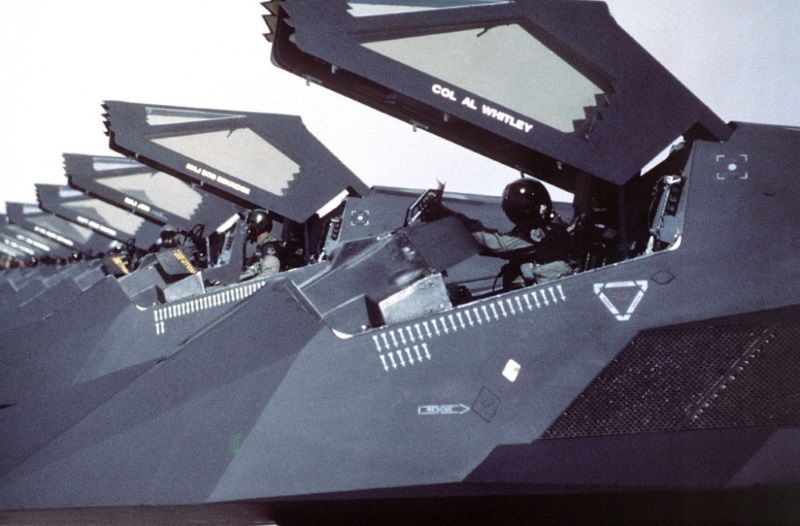
A detachment of F-117s had remained in Saudi Arabia at Tonopah East after the end of the Gulf War to help enforce sanctions against Iraq. After numerous violations of the cease-fire agreement, on 13 January 1991, six of the Nighthawks performed strikes on air-defense targets in southern Iraq. Results were mixed due to bad weather, but overall the strikes achieved their goals.
The F-117 was also used to some unknown extent during the occasional confrontations between the USAF and Iraqi air-defense systems during the 1990s. In some cases, F-117s were armed with HARM anti-radar missiles. F-16Cs would fly at a standoff distance from the area where air-defense sites were believed to be operating, while F-117s flew over the area. When an air-defense radar lit up, an F-117 would smack it with a HARM. F-117s played a role in the opening phases of the American invasion of Iraq in the spring of 2003. They were used on quick-reaction strikes, in attempts to kill Saddam Hussein and other Iraqi leadership by bombing bunkers using deep-penetration bombs.
* Three more F-117s were lost. One crashed into the Zuni Tribal Reservation on 5 April 1995; it was apparently another case of CFIT, the pilot being killed. Another F-117 broke up during an airshow near Baltimore, Maryland, on 14 September 1997, with the pilot ejecting safely. The crash was partly caught on video and occurred during a series of other accidents involving Air Force planes, giving it a high public profile. The 53 surviving F-117s were grounded while the problem was investigated, the conclusion being that the accident was due to the failure of a control surface.
The third loss was the first and only combat casualty for the F-117. The Nighthawk returned to active combat in the spring of 1999, when it participated in air attacks as part of Operation ALLIED FORCE, the NATO response to the conflict between Serbia and Kosovo. In the early morning hours of 28 March 1999, an F-117 was shot down by Serbian air defenses.
US defense experts eventually concluded the shoot-down was the result of poor mission planning, which plotted the same flight path over enemy territory four times in a row, and left the stealth aircraft unprotected by electronic countermeasures aircraft. The Serbs figured out the pattern and shot it down more or less by "Mark 1 Eyeball". The pilot was quickly rescued. However, in another embarrassment, the wreckage of the F-117 was not promptly bombed, and the Serbs invited their Russian allies to inspect the remains.
* The Air Force had something of an ambivalent attitude about the Nighthawk. After the Gulf War, the US Congress opposed the Air Force's effort to buy 72 new F-16 fighters, citing claims that the F-117 was "eight times more effective" than the F-16, and so the service could buy a much smaller number of F-117s to obtain the same effect.
That wasn't a story USAF brass liked to hear. The F-117 was designed as a specialized aircraft, basically a covert operations weapon, and for the majority of missions an F-16 could do the job much better. The F-117 lacked range, munitions capacity, and flexibility; it was also relatively expensive to operate. The service strongly opposed restarting production of the F-117, and no more Nighthawks were built. However, the F-117 was extremely effective for the mission for which it had been designed. Flight duty in the type was regarded as an attractive elite assignment, and pilots tended to be very experienced in other types of combat aircraft.
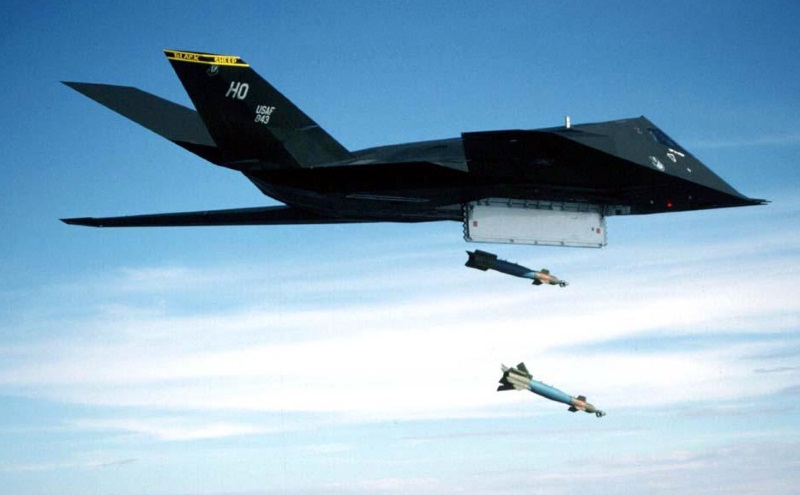
The aircraft posed challenges. Visibility from the faceted cockpit was poor, and was believed to have contributed to the CFIT accidents. F-117s tended to fly together in a tandem configuration because of the limited visibility, instead of wingtip-to-wingtip as in, say, an F-16. The fact that the pilot had to both fly and perform attacks by himself was another test of skill. The pilot needed to juggle multiple roles, allowing the autopilot system to direct him on final attack run to the target while he dropped the bomb and guided it to its target. Despite, or maybe because of, such challenges, one pilot called it "a marvel to fly" and "more cerebral" than other fighters. Its pilots praised its ability to perform extremely accurate strikes. They often simulated bombing "a guy's toolshed in his backyard, or something that small, just for practice."
BACK_TO_TOP* In the early 1990s, Lockheed tried to promote a number of naval versions of the F-117, with various designations such as the "F-117N" and "A/F-117X", with modified wing and tail surfaces. The US Navy wasn't interested.
Lockheed also suggested an "F-117B" to the USAF with more powerful engines to increase its range and payload, allowing it to carry over 8 tonnes (18,000 pounds) of bombs, four internally, four externally. The external weapons were to be covered with RAM to keep the aircraft stealthy. Military budgets were tight, and that idea went nowhere as well. Lockheed tried to promote the F-117 to the British Royal Air Force (RAF) as well. The company didn't make a sale, but it is interesting to note in this context that RAF pilots were qualified on and flew the F-117 as part of USAF-RAF military exchange programs.
* The Nighthawk was subjected to a stream of minor upgrades from its introduction to service, mostly under the "Offensive Capability Improvement Program (OCIP)", which was conducted in three phases, beginning in the late 1980s. OCIP 1 introduced an improved mission computer and support for the GBU-27 Paveway III LGB.
OCIP 2 provided an improved cockpit layout, featuring color multifunction displays (MFDs) to replace the older monochrome MFDs; a new data-entry panel; a "Flight Management System" that coupled the autopilot to the navigation system to allow the aircraft to automatically fly to a precise location; and a "Pilot Activated Automatic Recovery System (PAARS)". PAARS allowed the aircraft to return to the straight-and-level with a push of a button, and was designed specifically in response to the fatal accidents due to CFIT. F-117 pilots insisted they never used PAARS.
OCIP III replaced the older INS with a Global Positioning System / Inertial Navigation System (GPS/INS) module. Other upgrades included several updates to the IRADS targeting system; improvements to the engine exhaust system, which was a prominent source of trouble in the early days of the F-117; carbon-carbon brakes to replace the original steel brakes; a new composite-material fin; composite weapons-bay doors to replace the original metal doors; a MIL-STD 1760 munitions data bus; and an improved "Low Probability Of Intercept" secure communications system.
* The RAM scheme was a particular focus for improvements, not just to improve operational effectiveness but to simplify maintenance. Ground crews for the aircraft had particular challenges in dealing with the RAM that coated the aircraft. The RAM had to be scraped off to allow access to panels for maintenance, and razor blades, Exacto scrapers, and sprayguns were essential parts of the toolkit. The RAM was sensitive to moisture and fuel leaks, and so F-117 pilots tried to keep the aircraft as dry as possible.
Maintaining RAM was complicated by the fact that RAM schemes changed in production and differed from aircraft to aircraft. Early Nighthawks used a "wallpaper" or "applique" scheme to apply RAM, while later aircraft used spray-on RAM, and further tweaks were made in RAM processes. The final RAM schemes made access to panels easier and were significantly lighter than the original schemes, improving aircraft performance. In 2000, Lockheed Martin began a "Single Configuration Fleet (SCF)" effort to modify surviving F-117s to a consistent and up-to-date RAM configuration, with the intent of reducing maintenance overhead. A robotic system was used to apply the new RAM coating. The Air Force also flight-tested the F-117 in light overall gray colors for daylight operations. However, this appears to have just been a contingency exercise, since the type remained focused on night operations.
* The SCF effort was followed up with yet another set of upgrades, designated "Block 2", to allow the F-117 to carry newer munitions, particularly the EGBU-27 900-kilogram (2,000-pound) bomb, an enhanced version of the GBU-27 that added GPS/INS guidance to the existing laser guidance system. Other goals of the Block 2 upgrade were to permit integration of the new "Joint Direct Attack Munition (JDAM)" 900-kilogram (2,000-pound) GPS-guided bomb, and the "Wind Corrected Munitions Dispenser (WCMD)" INS-guided cluster bomb.
Adding a GPS-weapon capability to the F-117 gave the aircraft an all-weather attack capability, which had been sorely needed during the NATO Kosovo campaign. The upgrade allowed the F-117 to drop EGBU-27s that had been preprogrammed before take-off, but the pilot wasn't able to retarget the munition in flight. Initial test drops with JDAM were performed in early 2004, with the Block 2 upgrade reaching operational status in 2006.
* Further upgrades were considered, for example to replace obsolescent gear with new systems that would be cheaper and more capable. However, although the Air Force had planned to keep the Nighthawk in service until 2018, the introduction of the Lockheed-Martin F-22 Raptor provided the service with a much more modern and versatile stealthy fighter. Since the Nighthawk was expensive to operate, and there was no sense in maintaining two types of aircraft if one could do the job, the decision was made to put the F-117 out to pasture.
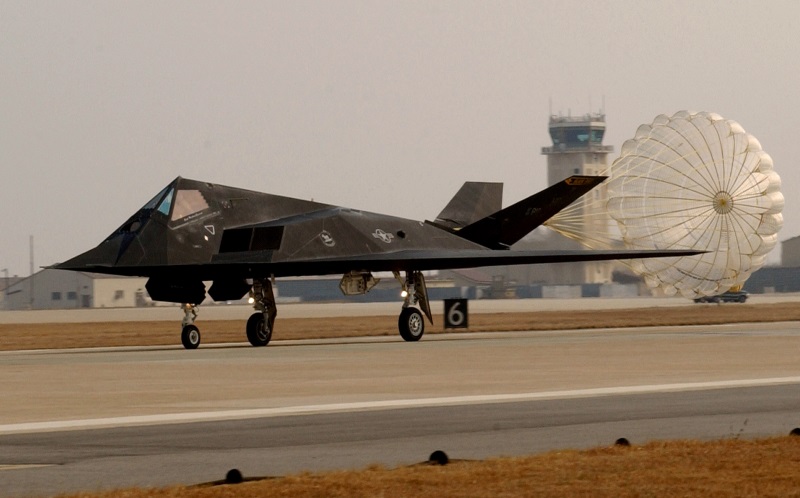
The final official flight of a Nighthawk was on 22 April 2008. The survivors were not sent to the "boneyard" at Davis-Monthan AFB near Tucson, Arizona, since they were still partly classified. They were placed in "recallable storage" at Tonopah, allowing them to be retrieved for duty if some occasion warranted it. A video taken by planespotters in July 2010 clearly showed an F-117 in flight, demonstrating that a few are still in service for test and evaluation purposes. In 2019, one F-117 was observed refueling from a tanker -- with this F-117 wearing disruptive camouflage colors, like those used by aggressor squadrons.
BACK_TO_TOP* As a footnote to the F-117 story, in October 2002 Boeing released details of a top-secret demonstrator aircraft that the company's secret Phantom Works organization had begun work on in 1992. The subsonic "Bird of Prey (BOP)", named for its general resemblance to a Klingon Bird of Prey warship from the STAR TREK TV series, was designed to evaluate new stealth technologies, as well as techniques for rapid development of flight prototypes. The program had many similarities to the HAVE BLUE effort.
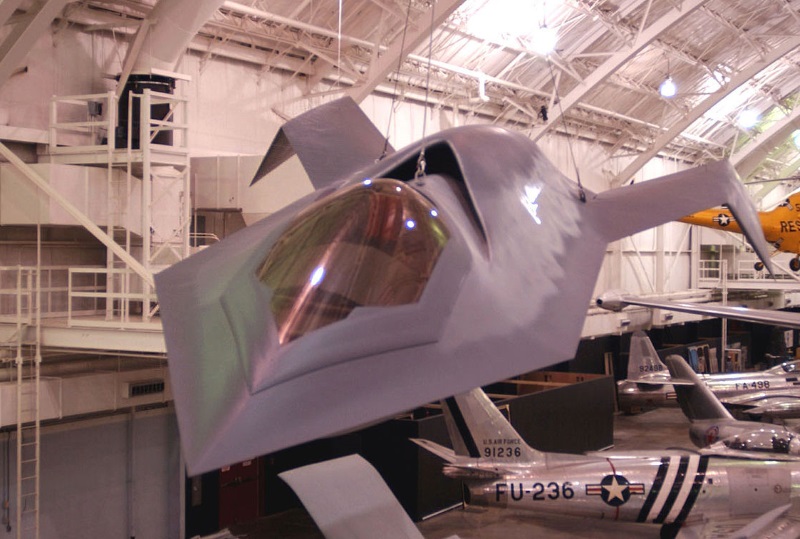
The BOP performed its first flight in the fall of 1996, conducting a total of 38 test flights into 1999 at the Groom Lake facility. The flights were performed by Boeing test pilots Rudy Haig and Joe Felock, as well as Doug Benjamin, then with the Air Force and later with Boeing.
The Bird of Prey had a flattened, lozenge-shaped fuselage, with rear-mounted swept gull wings and, initially, a dorsal fin. The intake for the aircraft's powerplant was on the back, almost buried behind the cockpit, with a slit exhaust in the tail. The aircraft was built largely of composites to reduce its radar cross-section. The top and bottom halves of the fuselage were almost single pieces.
The BOP was 14.2 meters (46 feet 8 inches) long, had a wingspan of 6.91 meters (22 feet 8 inches), was 2.82 meters (9 feet 4 inches) tall, and had a take-off weight of 3,346 kilograms (7,379 pounds). It was powered by a Pratt & Whitney JT15D turbofan, the same as used on some models of the Cessna Citation business jet, with 13.3 kN (1,360 kgp / 3,000 lbf) thrust.
Top speed of the BOP was only 480 KPH (260 knots), and since it was unpressurized, its ceiling was only 6,100 meters (20,000 feet). It used mechanical flight controls, linked to "rudderons" on the outer wing and "elevons" on the inner wing. Cockpit instruments were minimal, though it did have a GPS receiver. Pilots reported that it handled well, being very docile.
The Air Force oversaw the program, but Boeing provided all the funding, to the tune of $67 million USD. Off-the-shelf components were used wherever possible, including the ejection seat from an AV-8B Harrier, as well as parts from the F-15, F-18, and even a nosewheel from an F-100 Super Sabre. The BOP was donated to the Air Force Museum at Wright Patterson AFB in Ohio. Boeing stated that they had no intention of building an operational variant of the BOP, but that the technology validated in the flight test program was valuable to a wide range of company efforts.
BACK_TO_TOP* At least three F-117s are on public display, one at the USAF Museum at Wright-Patterson AFB in Ohio; one as a "gate guard" at Nellis Air Force Base; and one at the Lockheed Martin Skunk Works. All three are early evaluation prototypes. I was luckier than I knew to see one at an airshow in Wyoming in 2007, having no idea that the F-117 would be out of official service in a year's time.
The F-117 story is interesting, particularly because it gives insight into the nature of top-secret programs. The most interesting thing is how far off base most of the rumors were. Odd stories still float around about the machine. For example, soldiers guarding the aircraft in Saudi Arabia were said to have been startled by dead bats lying around the hangars. The bats had flown into the Nighthawks, which were as invisible to bat sonar as they were to human radar. Documenting it was simple, though, because there were only two versions: the HAVE BLUE prototype and the SENIOR TREND operational variant.
* Sources include:
* Illustrations details:
v1.0 / 01 nov 97 v2.0 / 01 jan 01 / Major update, went to two chapters. v2.0.1 / 01 jan 02 / Review & polish. v2.1.0 / 01 feb 03 / Added Boeing BOP comments. v2.1.1 / 01 feb 05 / Review & polish. v2.1.2 / 01 jan 07 / Review & polish. v2.1.3 / 01 apr 08 / F-117 retirement. v2.1.4 / 01 mar 10 / Review & polish. v2.1.5 / 01 feb 12 / Review & polish. v2.1.6 / 01 jan 14 / Review & polish. v2.1.7 / 01 dec 15 / Review & polish. v2.1.8 / 01 nov 17 / Review & polish. v2.1.9 / 01 oct 19 / Illustrations update. v2.2.0 / 01 aug 21 / Review & polish. v2.2.1 / 01 aug 23 / Review & polish. v2.2.2 / 01 aug 23 / Review & polish.BACK_TO_TOP
